Chachoengsao, located in the eastern region of Thailand, is home to many birds.
It is a paradise for birdwatchers, where they can observe rare species of birds, such as the critically endangered White-shouldered Ibis, the rare Pied Harrier, and the endangered Black-headed Ibis.
Other species of birds that can be spotted in Chachoengsao include the Common Myna, the White-rumped Shama, and the Oriental Magpie Robin.
With its lush mangrove forests, freshwater marshes, and agricultural areas, Chachoengsao is an excellent destination for birdwatching.
1. Lesser Whistling Duck
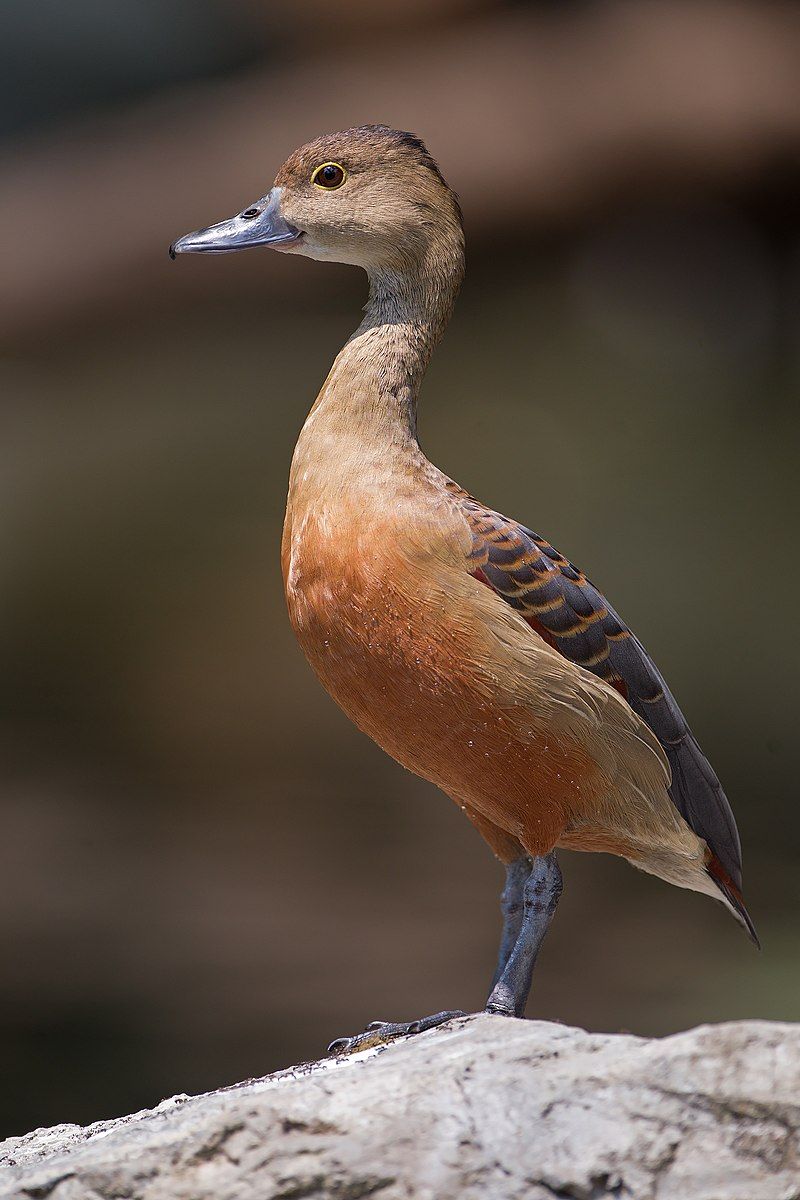
The lesser whistling duck is found in the Indian subcontinent and Southeast Asia. It is also known as the Indian whistling duck or lesser whistling teal. This duck species is nocturnal, meaning it feeds during the night.
During the day, the lesser whistling duck can often be found in large flocks around lakes and wet paddy fields. They are generally seen in groups because they are social birds that like to remain near one another.
These ducks have a unique whistling call that can be heard from up to two kilometers away. Their feathers are reddish-brown with white stripes, and they have short legs and long necks. Males and females look the same, with the males being slightly larger.
They use their long necks to reach into the water to feed on aquatic plants and small invertebrates. They also eat small insects, seeds, and grains. The lesser whistling duck is considered a “near-threatened” species due to the destruction of its habitat.
Wetlands are often drained to make room for agriculture and housing, which leads to a decrease in the number of ducks. Conservation efforts have been put in place to help protect these birds and their habitats.
| Kingdom | Animalia |
| Phylum | Chordata |
| Class | Aves |
| Order | Anseriformes |
| Family | Anatidae |
| Genus | Dendrocygna |
| Species | D. javanica |
2. White-Breasted Waterhen
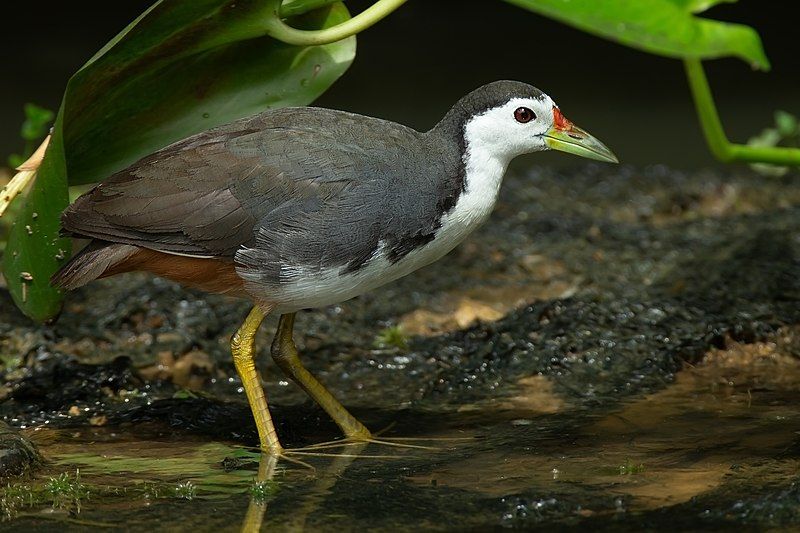
The white-breasted waterhen is a species of waterbird from the Rallidae family. It is found in multiple countries across South and Southeast Asia. This waterbird species is characterized by its dark, slaty feathers and a white face, breast, and belly.
This distinct coloration helps to make the white-breasted water easily recognizable. This waterbird species lives mainly in fresh and saltwater wetlands, such as marshes, rivers, lakes, and coasts.
It prefers shallow water and is often seen walking on the shoreline or swimming in the shallows. They feed mainly on aquatic invertebrates, such as insects, crustaceans, and mollusks. They also feed on seeds, fruits, and grasses.
The white-breasted waterhen is a social bird, often found in flocks of up to 50 individuals. During the breeding season, the male white-breasted waterhen establishes a territory and attracts a mate with loud calls.
The pair will then construct a nest near the water’s edge, often made of twigs and grasses. The female will lay up to five eggs in the nest, and both parents will help incubate them until they hatch. The young are capable of flight after about three weeks.
The white-breasted waterhen is an essential species for its local ecosystem. It serves as a keystone species, as it helps maintain aquatic habitats’ health by consuming insects and other pests.
They are also an important food source for many other species, such as foxes, snakes, and larger birds. For these reasons, protecting the white-breasted water and its habitat is essential.
| Kingdom | Animalia |
| Phylum | Chordata |
| Class | Aves |
| Order | Gruiformes |
| Family | Rallidae |
| Genus | Amaurornis |
| Species | A. phoenicurus |
3. Red-Wattled Lapwing
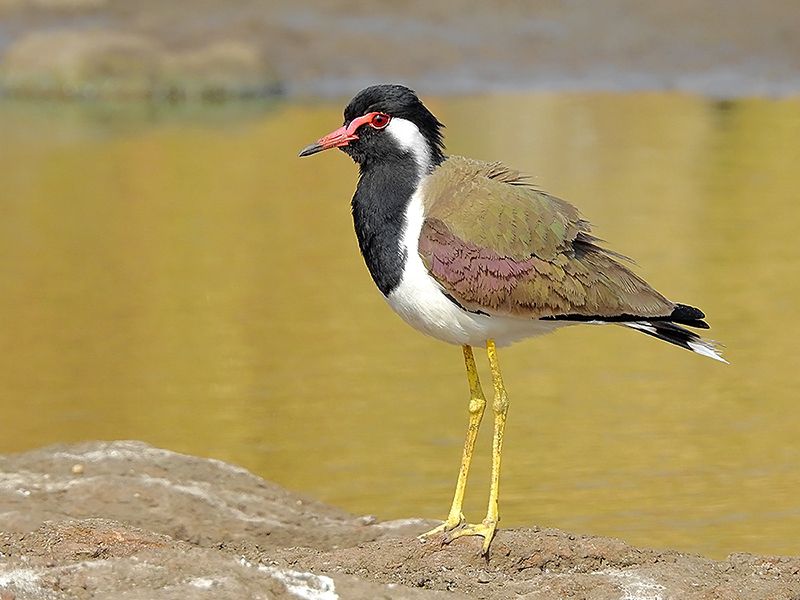
The red-wattled lapwing is a species of wading bird found in Asia. It is a member of the Charadriidae family, a group of large plovers. As a lapwing, the red-wattled lapwing spends most of its time on the ground.
It is known for its distinctive red wattle near the beak, which can be seen when the bird is in flight. It is also notable for its inability to perch, like other lapwings. This is because the bird’s legs are not adapted for perching in the same way as different bird species.
Instead, it spends most of its time foraging for food on the ground and will take off in flight when disturbed. The red-wattled lapwing is essential in its ecology, providing important insect control and food for predators.
It is also an important species in terms of its cultural significance, with its distinctive call being used as an essential alarm call in many regions of Asia.
| Kingdom | Animalia |
| Phylum | Chordata |
| Class | Aves |
| Order | Charadriiformes |
| Family | Charadriidae |
| Genus | Vanellus |
| Species | V. indicus |
4. Great Egret
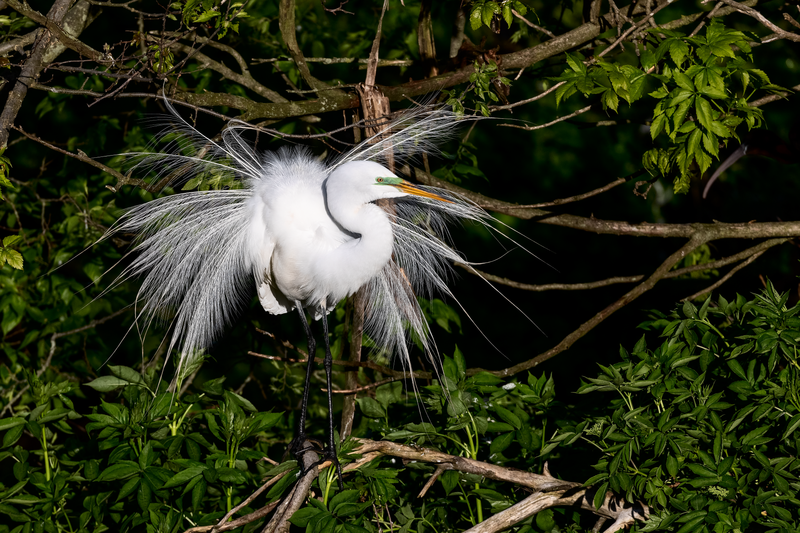
The great egret is a large bird in many parts of the world. It is commonly known as the common egret, large egret, great white egret, or great white heron.
It is divided into four subspecies: Asiaa, Africa, the Americas, and southern Europe. In recent years, it has been spreading its wings further north and is now found in more northern areas of Europe.
The great egret is a majestic-looking bird with white plumage and a long yellow bill. It stands up to three feet tall and has a wingspan of almost five feet. It is an opportunistic feeder, foraging for food in fresh and saltwater habitats.
It mainly feeds on aquatic creatures such as frogs, fish, and insects but also eats small birds, mammals, and snakes. The great egret is a migratory species and can be seen in both summer and winter months.
During the breeding season, it nests in colonies, often in wetlands or other areas close to water. It builds its nests on the ground or in low trees, such as willows and cottonwoods.
It is considered a symbol of luck in some cultures, and its beauty and grace have made it a popular subject for art and photography. The great egret is a species of conservation concern due to habitat destruction and hunting for its feathers.
It is protected in many countries, and its population is increasing in some areas, but it is still a vulnerable species. The great egret is an integral part of the natural world and signifies a healthy environment.
| Kingdom | Animalia |
| Phylum | Chordata |
| Class | Aves |
| Order | Pelecaniformes |
| Family | Ardeidae |
| Genus | Ardea |
| Species | A. alba |
5. Spotted Dove
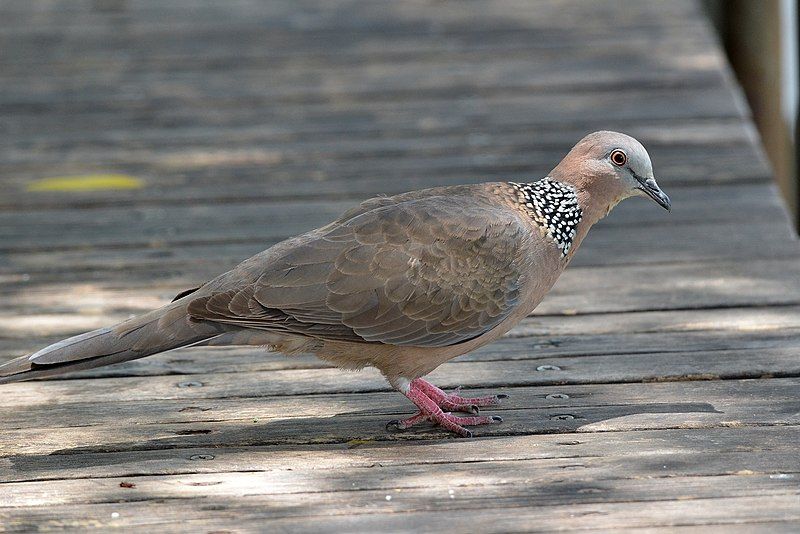
The spotted dove is a small, rather long-tailed pigeon found in abundance in various parts of India and Southeast Asia. It is a common resident breeding bird in these regions, meaning that it is found in these areas year-round.
The species has also been introduced to many other parts of the world and successfully established feral populations in these new locations. This is due to its adaptability and its ability to thrive in a variety of different environments.
The spotted dove is notable for its distinctive coloration, with its head, neck, and breast being pale grey-brown, and its wings and tail having a spotted pattern. Its diet consists mainly of grains, seeds, and some insects.
| Kingdom | Animalia |
| Phylum | Chordata |
| Class | Aves |
| Order | Columbiformes |
| Family | Columbidae |
| Genus | Spilopelia |
| Species | S. chinensis |
6. Black-Winged Stilt
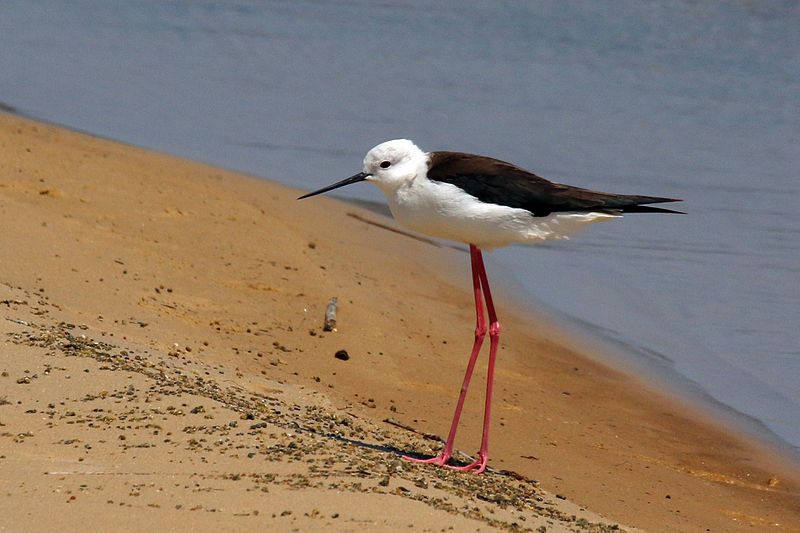
The black-winged stilt is a wader bird species found in many regions of the world. It belongs to the avocet and stilt family and is distinguished by its long, thin legs. It has a wide range on many continents, including Africa, Asia, Europe, and Australasia.
The scientific name for the species is H. himantopus. This species is considered to be almost cosmopolitan in its range, meaning it is found in many different parts of the world. The black-winged stilt is a medium-sized bird, measuring around 35–40 cm in length.
It has a black and white plumage, with the wings being black and the body white. The legs are long and thin, usually red or pink. The bill is slender and pointed, and the eyes are dark and bright.
The black-winged stilt feeds mainly on aquatic insects and small fish, tadpoles, and other small animals. It typically walks along the shoreline for food and can sometimes be seen wading in shallow water.
It builds its nest in shallow water or on the ground and usually lays two to three eggs. The black-winged stilt is an essential species in its range, as it helps to maintain the balance of aquatic ecosystems.
It is an important food source for many predators and helps control the populations of other species, such as insects. As a result, it is essential to conserve this species and its habitats to protect the environment.
| Kingdom | Animalia |
| Phylum | Chordata |
| Class | Aves |
| Order | Charadriiformes |
| Family | Recurvirostridae |
| Genus | Himantopus |
| Species | H. himantopus |
7. Thick-Billed Green Pigeon
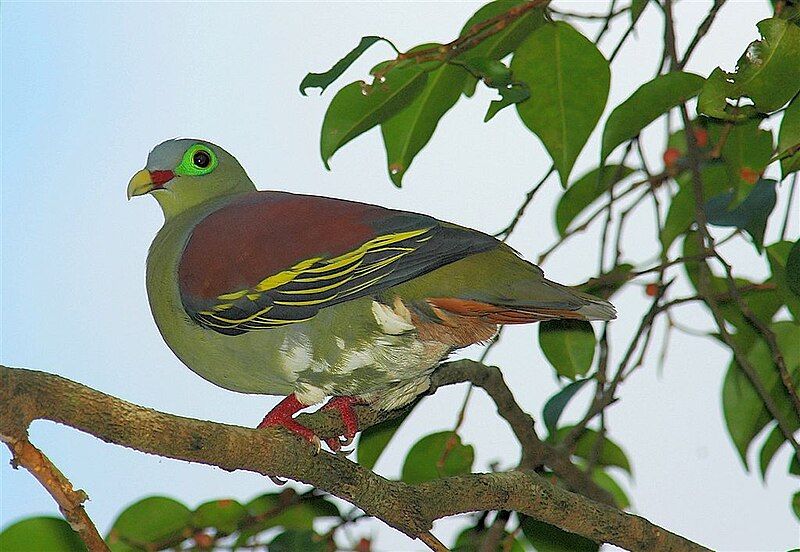
The thick-billed green pigeon is a species of bird belonging to the family Columbidae, which is made up of species commonly known as pigeons and doves. Columbidae is one of the most widespread bird families, with species found in virtually all parts of the world.
The thick-billed green pigeon is a member of this family and is noted for its distinctive bill shape and greenish-gray coloration. The bird is native to Sri Lanka and parts of India and is typically found in forests and woodlands.
It typically feeds on fruits and nuts, as well as the occasional insect. The thick-billed green pigeon is a medium-sized bird, measuring around 33 cm in length. Males and females look very similar, but females are slightly smaller than males.
The thick-billed green pigeon typically nests in trees, building a large platform of twigs and branches. The species is not threatened and is considered to be of least concern by conservationists.
| Kingdom | Animalia |
| Phylum | Chordata |
| Class | Aves |
| Order | Columbiformes |
| Family | Columbidae |
| Genus | Treron |
| Species | T. curvirostra |
8. Pink-Necked Green Pigeon
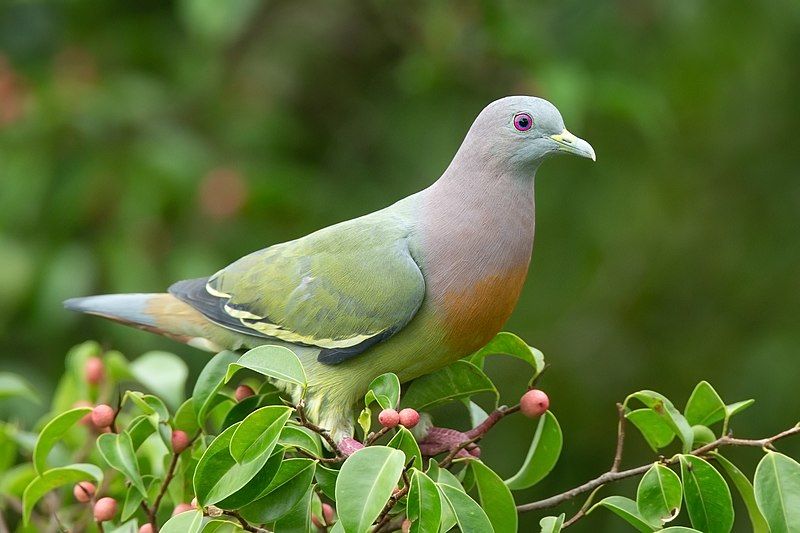
The pink-necked green pigeon is a species of bird belonging to the Columbidae family, which consists of pigeons and doves. This species is found predominantly in Southeast Asia, ranging from Myanmar and Vietnam to the major islands of Indonesia and the Philippines.
It is considered a common species in this area and is often seen in gardens, parks, and woodlands. The pink-necked green pigeon has a distinctive appearance, with its bright green upperparts and pink neck.
Its underparts are a lighter shade of green, giving the bird a two-toned coloration. The male and female of the species look pretty similar, although the male may have a slightly darker neck than the female.
The wings are grayish-brown, and the tail is dark brown with a white tip. The overall size of the species is relatively small, with adult birds measuring around 25-30 cm in length. The pink-necked green pigeon feeds mainly on seeds, fruits, and insects.
They are usually seen in small groups, foraging on the ground or among the foliage of trees and shrubs.
When threatened, they will flee into the foliage or take flight, which they do with a rapid and robust flapping of their wings. The pink-necked green pigeon is a social species, and they often gather in large numbers to roost at night.
During the breeding season, males often perform courtship displays to attract a mate. The nest is usually built in a tree or bush, and the female will lay two eggs, incubated for two weeks before hatching.
After hatching, the young birds will be cared for by both parents until they can fly and care for themselves.
| Kingdom | Animalia |
| Phylum | Chordata |
| Class | Aves |
| Order | Columbiformes |
| Family | Columbidae |
| Genus | Treron |
| Species | T. vernans |
9. Chinese Pond Heron
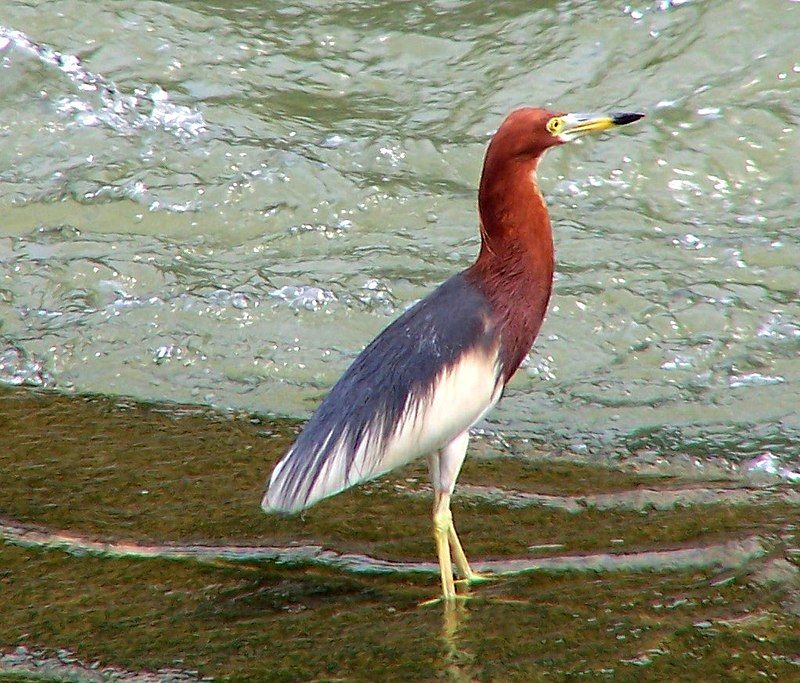
The Chinese pond heron is a species of bird in the heron family which is endemic to East Asia. It is one of six species of herons known as “pond herons,” which inhabit various freshwater bodies such as ponds, lakes, and rivers.
This species is closely related to two other pond herons, the Indian pond heron and the Javan pond heron, and together they are thought to form a superspecies.
The Chinese pond heron is parapatric with the Indian pond heron, meaning they share overlapping but non-contiguous ranges. The Indian pond heron is found to the west of the Chinese pond heron’s range, while the Javan pond heron is found to the south.
This close relationship between the three species results from their shared evolutionary history.
| Kingdom | Animalia |
| Phylum | Chordata |
| Class | Aves |
| Order | Pelecaniformes |
| Family | Ardeidae |
| Genus | Ardeola |
| Species | A. bacchus |
10. Garganey
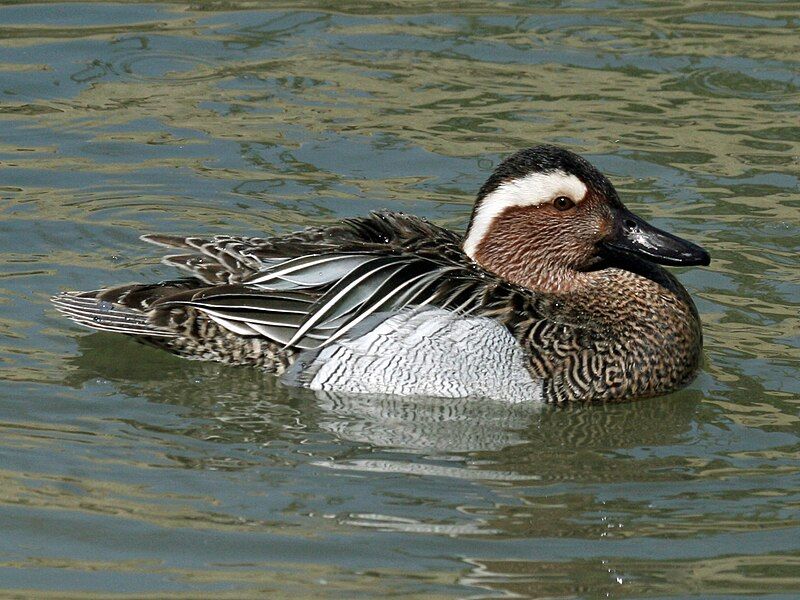
The garganey is a small duck found across a large world area. It breeds in many parts of Europe and the Palearctic region, which covers much of the northern hemisphere.
During the winter, the garganey migrates to warmer climates, like southern Africa, India, Bangladesh, and Australasia. Once there, these birds congregate in large flocks, taking advantage of the warmer weather and plentiful food sources.
The garganey is an impressive example of animal migration. These ducks must travel thousands of miles each year to survive. It is a journey they must make yearly, and it is a testament to their strength and resilience.
Without this incredible migration ability, the Garganey population would be significantly diminished.
| Kingdom | Animalia |
| Phylum | Chordata |
| Class | Aves |
| Order | Anseriformes |
| Family | Anatidae |
| Genus | Spatula |
| Species | S. querquedula |
11. Chestnut-Winged Cuckoo
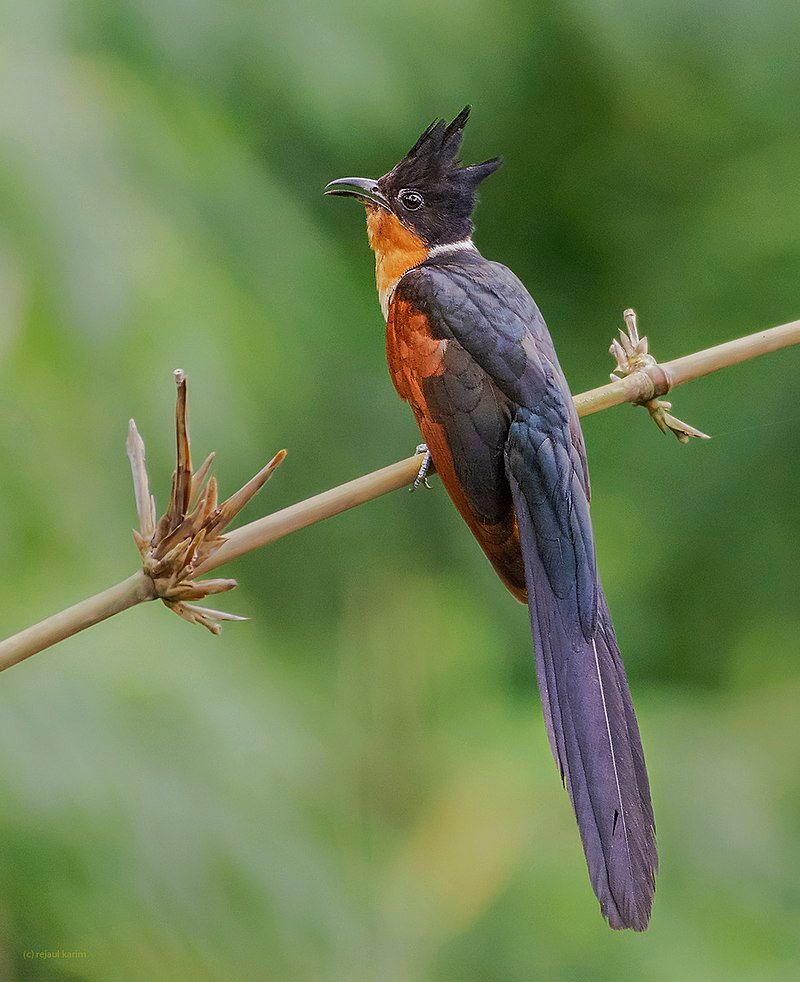
The chestnut-winged cuckoo or red-winged crested cuckoo is a species of cuckoo found in Southeast Asia and parts of South Asian regions.
This species of cuckoo has a very distinct look, with dark, glossy upperparts, a black head with a long, feathered crest, chestnut-colored wings, a long, shiny black tail that tapers off in length, a rufous-colored throat, a dusky underside, and a narrow white nuchal half collar.
The chestnut-winged cuckoo is an impressive-looking bird with its glossy black feathers, chestnut wings, and long, elegant crest. The combination of colors and textures is striking and makes this cuckoo species easily identifiable in its natural habitat.
The chestnut-winged cuckoo is an active bird, often seen flying around its habitat looking for food, and is known to be a strong flyer. Its thick feathers help it stay warm in cooler temperatures, and it uses its crest to communicate with other cuckoos.
This species is an integral part of the Southeast Asian and South Asian bird communities, and its unique appearance is a sight to behold.
| Kingdom | Animalia |
| Phylum | Chordata |
| Class | Aves |
| Order | Cuculiformes |
| Family | Cuculidae |
| Genus | Clamator |
| Species | C. coromandus |
12. Striated Heron
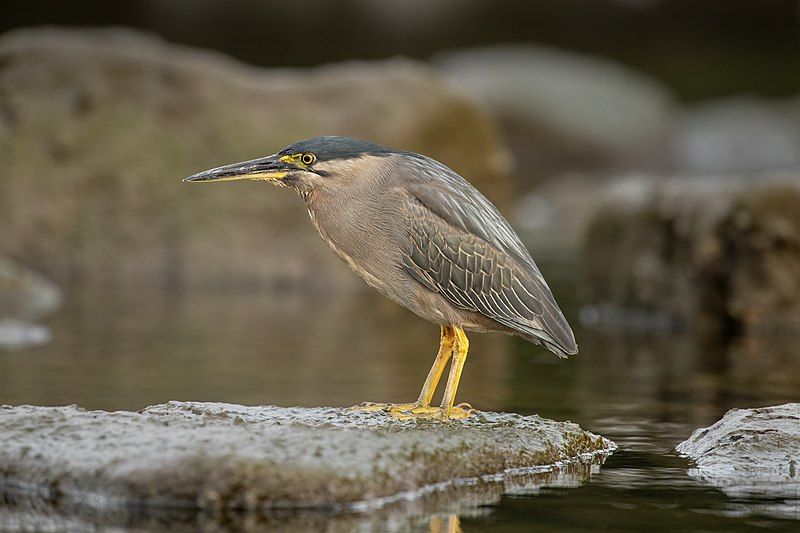
The Striated Heron is a small wading bird, typically 44 cm tall, in tropical and subtropical regions worldwide. Its other names include Mangrove Heron, Little Green Heron, and Green-Backed Heron.
Generally, they prefer to stay in one place and not migrate and are known for their unique behaviors. Striated Herons are usually seen in shallow water, searching for aquatic prey like small fish, frogs, and insects.
They also eat small land animals such as lizards, snakes, and rodents—the herons hunt by stalking their prey and waiting for it to come within striking distance.
When they spot their target, they swoop to snatch it up quickly and silently. In addition to their impressive hunting skills, Striated Herons exhibit other exciting behaviors.
They are known for “anting,” where they spread their wings and cover themselves with ants. This behavior is believed to serve as a form of pest control, as the ants may act as a form of protection against other parasites.
The herons also perform a “dancing” ritual, where they raise their wings and sway their necks and heads in a circular motion.
This behavior is thought to be a form of courtship display. The Striated Heron is a fascinating bird with unique behaviors and impressive hunting skills. It is an integral part of the tropical and subtropical ecosystems and is a pleasure to watch.
| Kingdom | Animalia |
| Phylum | Chordata |
| Class | Aves |
| Order | Pelecaniformes |
| Family | Ardeidae |
| Genus | Butorides |
| Species | B. striata |
13. Large-Tailed Nightjar
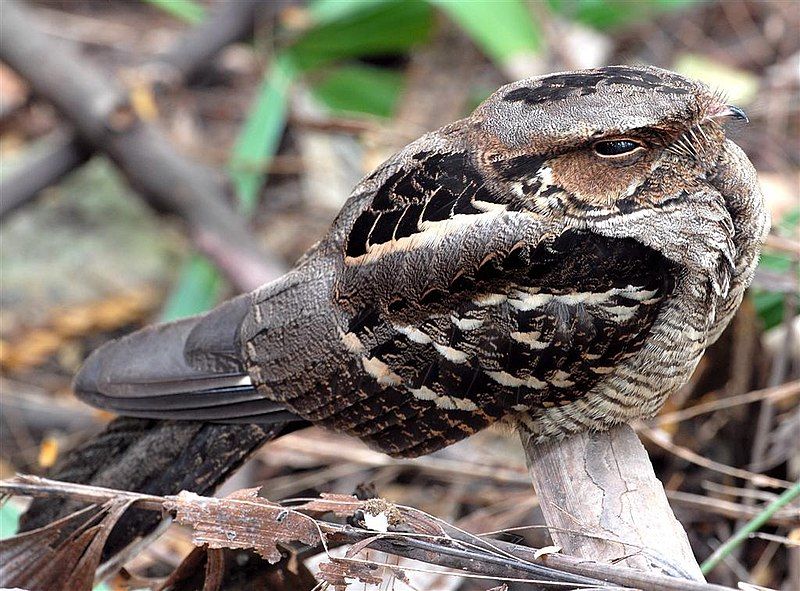
The Large-tailed Nightjar is a species of nightjar found in the family Caprimulgidae. It is a nocturnal bird usually found in areas with low light levels. It has a large tail that can reach up to 33 cm in length.
Its habitat includes the southern Himalayan foothills, eastern South Asia, Southeast Asia, and northern Australia. It has a brownish-gray color with a unique pattern of spots and stripes, and its wings are long and pointed.
It is a very silent bird and usually remains hidden during the day, seeking shelter in shrubs and trees. It is active at night, and its diet includes small insects such as moths, beetles, and cicadas. It also feeds on fruits and berries.
Its call is distinctive and consists of a loud, continuous shooting. This species is considered to be of least concern by the International Union for Conservation of Nature due to its extensive range and the fact that human activities do not threaten it.
| Kingdom | Animalia |
| Phylum | Chordata |
| Class | Aves |
| Clade | Strisores |
| Order | Caprimulgiformes |
| Family | Caprimulgidae |
| Genus | Caprimulgus |
| Species | C. macrurus |
14. Blue-Breasted Quail
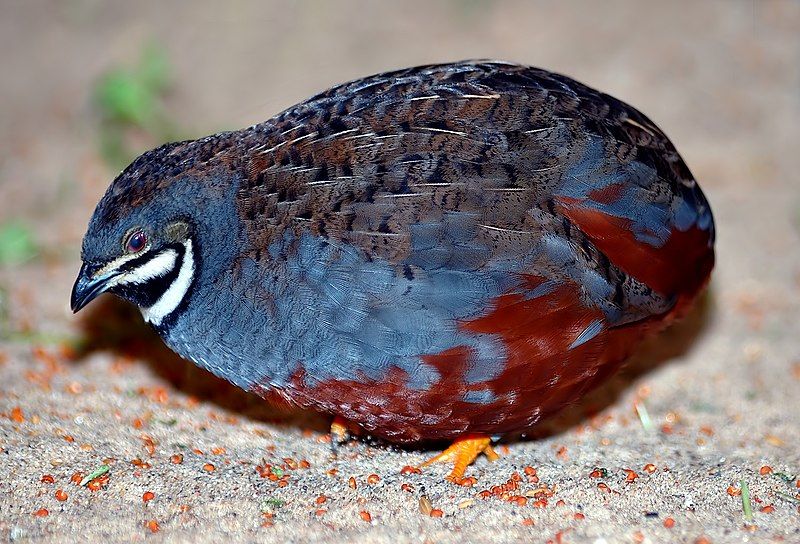
The king quail is a species of quail found in the Old World. It is a ground bird native to parts of India, Southeast Asia, and China. Several other names, such as the blue-breasted quail, Asian blue quail, Chinese painted quail, and Chung-Chi, also know it.
This quail species is part of the Phasianidae family, which includes other members such as the chukar, partridge, and pheasant. The king quail is a small brown bird with some white and black markings.
It has a distinctive blue breast, one of its most recognizable features. This species of quail is monogamous and lives in pairs.
They feed mainly on seeds and insects but can consume some fruits and vegetables. The king quail is often kept as a pet due to its attractive colors and relatively easy care. They can be kept in an aviary or a spacious cage.
They require a specific diet, including various seeds, grains, and greens. The king quail is considered a game bird in some parts of the world, and hunting them is allowed in certain areas. This species of quail is also essential in the pet trade.
The chicks are often sold for breeding, and the adults are sometimes used for meat. In addition, their feathers are used to make traditional costumes. The king quail is an exciting Old World species recognized by its unique blue breast.
It is kept as a pet, hunted as a game bird, and is used in the pet trade.
| Kingdom | Animalia |
| Phylum | Chordata |
| Class | Aves |
| Order | Galliformes |
| Family | Phasianidae |
| Genus | Synoicus |
| Species | S. chinensis |
15. Javan Pond Heron
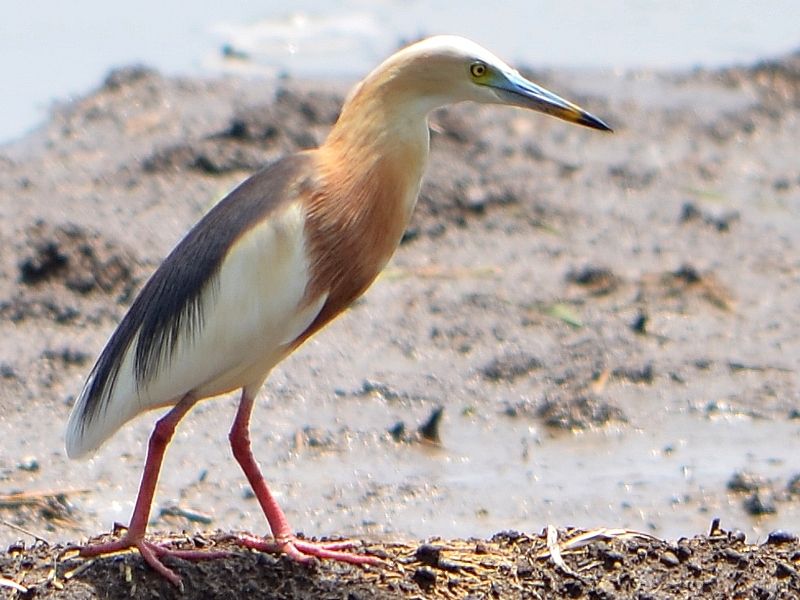
The Javan pond heron is a species of wading bird that belongs to the heron family. It is native to Southeast Asia and can be found in a variety of wetlands, including both fresh and salt water. It has a unique physical appearance that makes it easy to recognize.
It typically measures 45 cm long and has white wings, a yellow bill with a black tip, yellow eyes, and yellow legs. The Javan pond heron has a varied diet, consisting of several types of insects, fish, and crabs.
This heron species is particularly adept at finding prey in shallow waters, using its long bill to search for food.
It is also an efficient hunter, using its wings to help it maneuver quickly in pursuit of its prey. The Javan pond heron is an integral part of the Southeast Asian ecosystem. It helps keep the wetlands healthy by balancing insect and fish populations.
This species is also an essential part of the local economy, providing food for subsistence fishermen and a source of income for those who hunt it for its feathers. Overall, the Javan pond heron is an impressive bird that has adapted to the demands of its environment.
Its unique physical features and skillful hunting methods make it a fascinating creature to observe, and its importance to the Southeast Asian ecosystem makes it an essential part of the local ecosystem.
| Kingdom | Animalia |
| Phylum | Chordata |
| Class | Aves |
| Order | Pelecaniformes |
| Family | Ardeidae |
| Genus | Ardeola |
| Species | A. speciosa |
16. Greater Flamingo
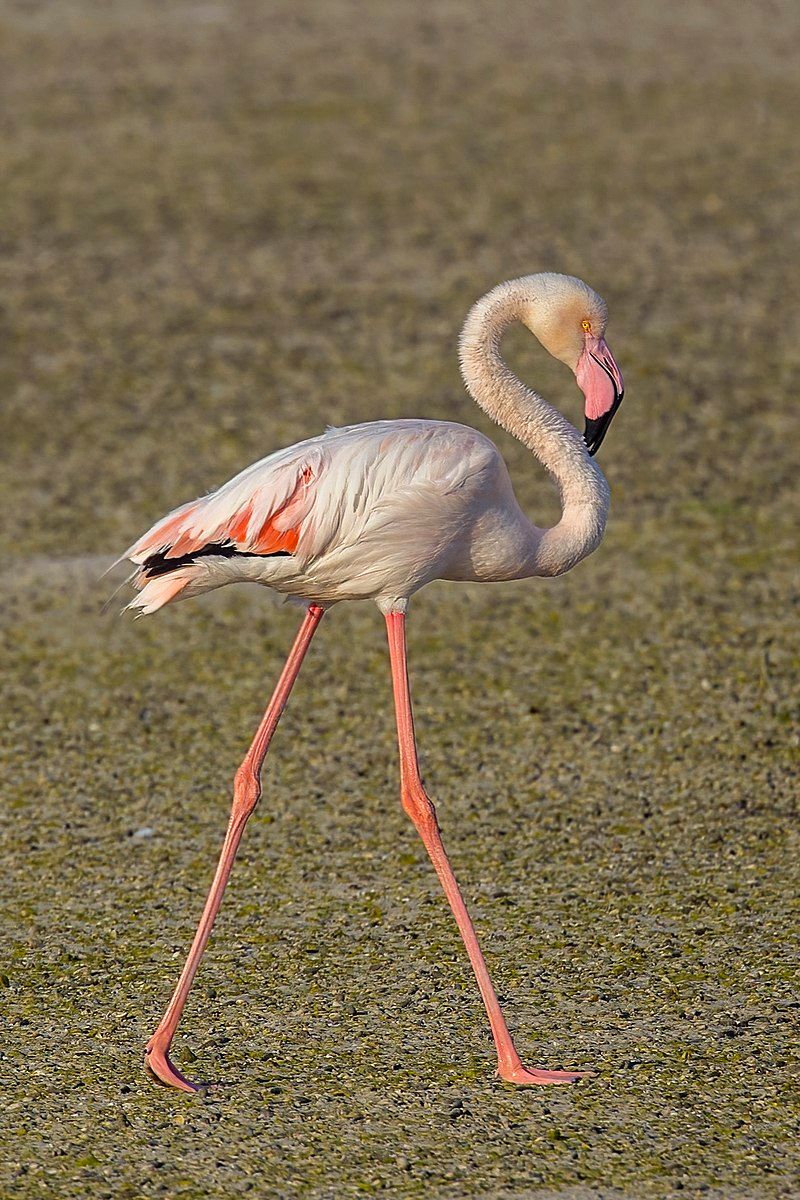
The greater flamingo is the most significant and widespread species of the family.
These birds are found in many parts of the world, including Northern and Sub-Saharan Africa, the Indian Subcontinent, the Middle East, the Levant, the Persian Gulf, the Gulf of Aden, the Red Sea, and the Mediterranean countries of Southern Europe.
Generally, these birds are considered exceptionally social and congregate in large groups, especially when looking for food. They feed mainly on tiny aquatic organisms but consume some plant matter.
Greater flamingos have an unmistakable appearance: long necks and legs, curved bills, and pinkish-white feathers. The range of the greater flamingo is vast, and they can be seen in many different places around the world.
Their presence is a testament to their resilience and adaptability, as they can thrive in many different habitats.
| Kingdom | Animalia |
| Phylum | Chordata |
| Class | Aves |
| Order | Phoenicopteriformes |
| Family | Phoenicopteridae |
| Genus | Phoenicopterus |
| Species | P. roseus |
17. Orange-Breasted Green Pigeon
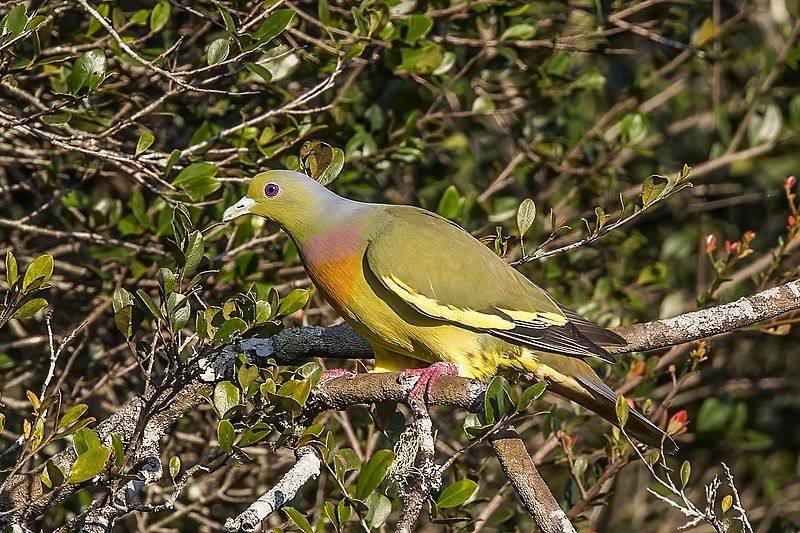
The orange-breasted green pigeon is a species found in tropical parts of Asia. It can be found south of the Himalayas, across the Indian Subcontinent, and in Southeast Asia.
These pigeons are similar to other green pigeons in that they primarily feed on small fruits. They tend to stay in pairs or small flocks when searching for food and quietly and slowly move around trees. These pigeons have a unique and striking appearance.
They have a green body, and the head and breast are orange. They have a white line that runs across their wings, and they have a black tail that is tipped in white. The orange-breasted green pigeon is an important species of bird in the region it inhabits.
It plays a role in dispersing seeds of the plants it feeds on. This helps maintain healthy populations of these plants and the habitats in which they grow.
They are hunted for their meat, and their feathers are sometimes used in traditional ceremonies and other purposes. Overall, the orange-breasted green pigeon is an important species to the environment and local cultures.
Its beauty and ability to help maintain the health of local ecosystems make it an essential species in the region it inhabits.
| Kingdom | Animalia |
| Phylum | Chordata |
| Class | Aves |
| Order | Columbiformes |
| Family | Columbidae |
| Genus | Treron |
| Species | T. bicinctus |
18. Ruddy-Breasted Crake
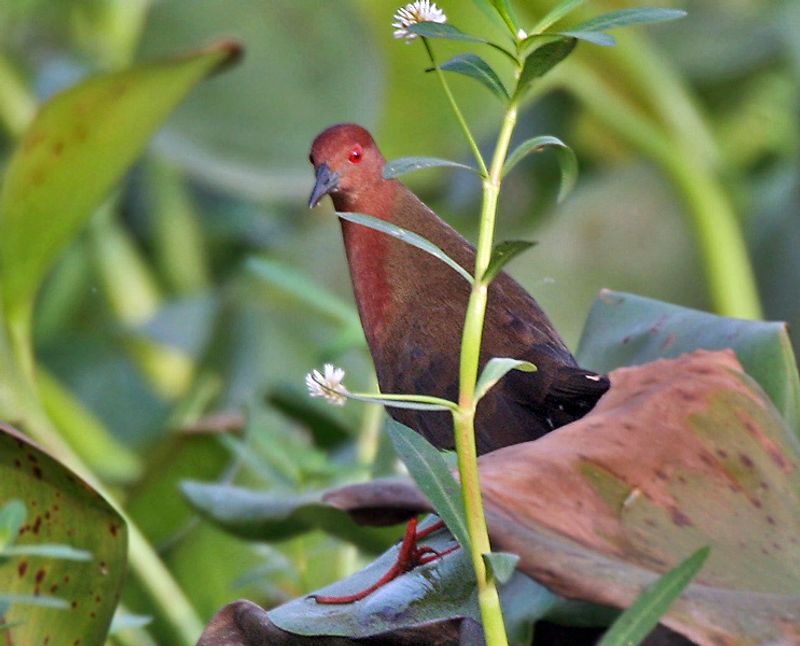
The Ruddy-breasted Crake, also known as the Ruddy Crake, is a species of waterbird in the rail and crake family Rallidae. This family includes many species of marsh-dwelling birds, such as gallinules, coots, and moorhens.
The Ruddy-breasted Crake is a medium-sized bird with a reddish-brown breast and a dark gray back. It has a short, thin neck and a yellowish bill and feet. The Ruddy-breasted Crake is native to South Asia, ranging from the Indian subcontinent to China, Japan, and Indonesia.
Its breeding grounds are usually found in swamps, ponds, and other wet areas, where it prefers to nest in tall grass or reeds.
The Ruddy-breasted Crake feeds mainly on insects and crustaceans but also eats small fish, frogs, and other aquatic animals. The Ruddy-breasted Crake is usually found in small to medium flocks of no more than six birds.
They are timid and challenging to observe in the wild. Their population appears to be stable, and they are not considered to be endangered species.
| Kingdom | Animalia |
| Phylum | Chordata |
| Class | Aves |
| Order | Gruiformes |
| Family | Rallidae |
| Genus | Zapornia |
| Species | Z. fusca |
19. Large Hawk-Cuckoo
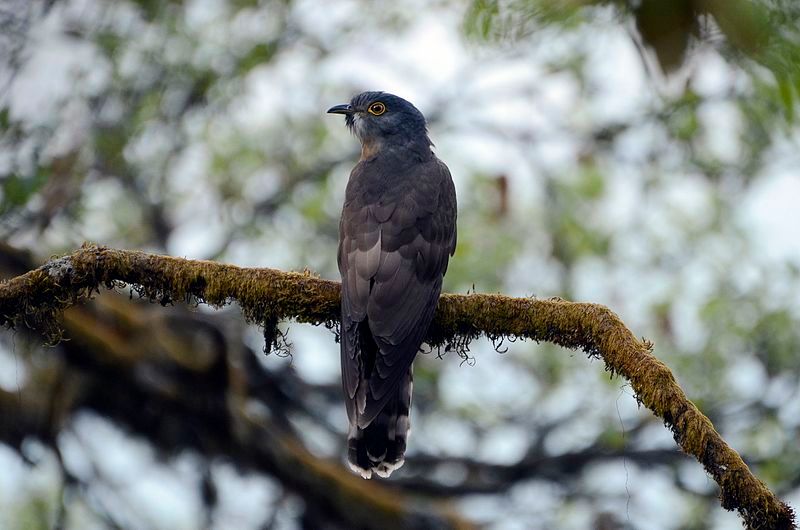
The large hawk-cuckoo is a cuckoo species belonging to the family Cuculidae. This cuckoo can be found in temperate parts of Asia, including areas along the Himalayas and in East Asia.
This species is known for its wide breeding distribution, as it can be found in these areas all year round. However, many populations of this species migrate south during the winter months to find warmer climates.
This allows them to survive the cold winter and gives them access to more food sources. Because of this, the large hawk-cuckoo is an incredibly adaptable species that can thrive even in changing environments.
| Kingdom | Animalia |
| Phylum | Chordata |
| Class | Aves |
| Order | Cuculiformes |
| Family | Cuculidae |
| Genus | Hierococcyx |
| Species | H. sparverioides |
20. Bronze-Winged Jacana
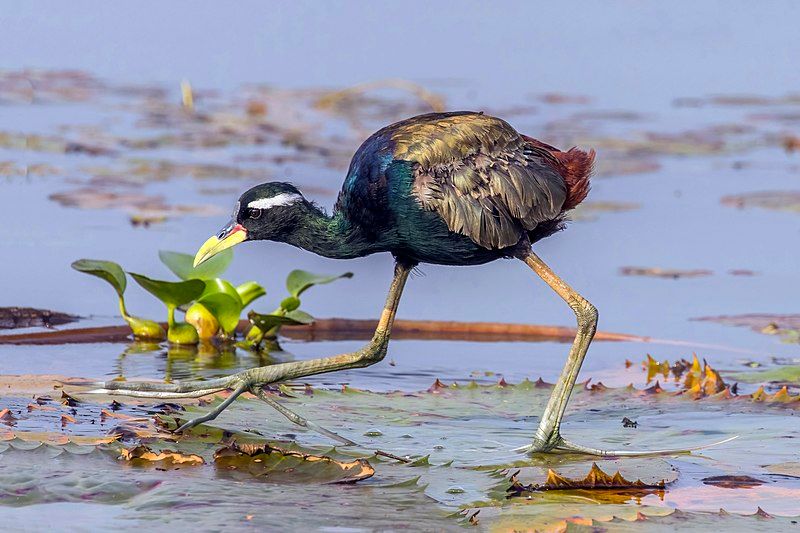
The bronze-winged jacana is a unique species of wader belonging to the family Jacanidae. It is found across many South and Southeast Asian habitats and is the only species in its genus, Metopidius.
These birds are well-adapted to life in and around aquatic environments, with their extremely long legs allowing them to walk across the surface of lily ponds and other bodies of water.
This adaptation also helps them avoid sinking, with the long legs spreading out their weight across the water’s surface. When foraging, the bronze-winged jacana depends mainly on aquatic vegetation like lilies, which it can find floating on the water’s surface.
This species can survive in various habitats, from freshwater and brackish wetlands to mangrove forests and even urban environments. As a result, it has become a common sight in many parts of South and Southeast Asia.
The bronze-winged jacana is an essential part of the local ecology and a beloved sight in many of these areas.
| Kingdom | Animalia |
| Phylum | Chordata |
| Class | Aves |
| Order | Charadriiformes |
| Family | Jacanidae |
| Genus | Metopidius |
| Species | M. indicus |
21. Purple Heron
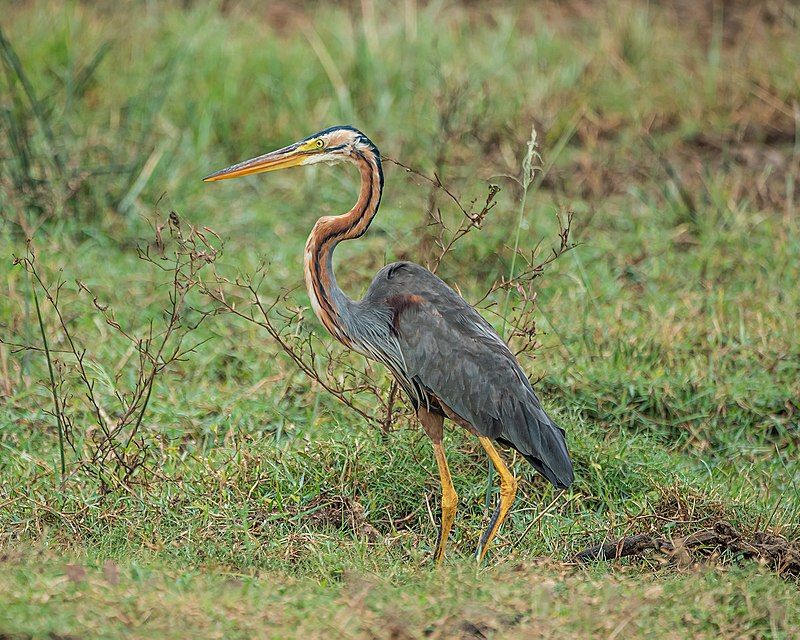
The purple heron is a species of wading bird found across various regions. It is a member of the heron family Ardeidae and is scientifically named for its distinct purple coloring.
This bird breeds in Africa, central and southern Europe, and southern and eastern Asia.
The scientific name for the purple heron is derived from Latin, with ardea meaning heron and purpureus meaning colored purple. The purple heron is a large bird typically standing around 3 feet tall. They have long legs and a long neck that is typical of herons.
The feathers of the adult purple heron are usually a deep purple-blue color, but the young are more brown with streaks of white and purple. The purple heron is a solitary bird that feeds mainly on small fish, aquatic insects, and other creatures.
They hunt from a stationary position or while flying low over the water. They nest in tall trees, often near water, and may use the same nesting site yearly. The purple heron is a fascinating bird in many parts of the world.
Its unique coloring and behavior make it a beautiful bird to observe.
| Kingdom | Animalia |
| Phylum | Chordata |
| Class | Aves |
| Order | Pelecaniformes |
| Family | Ardeidae |
| Genus | Ardea |
| Species | A. purpurea |
22. Painted Stork
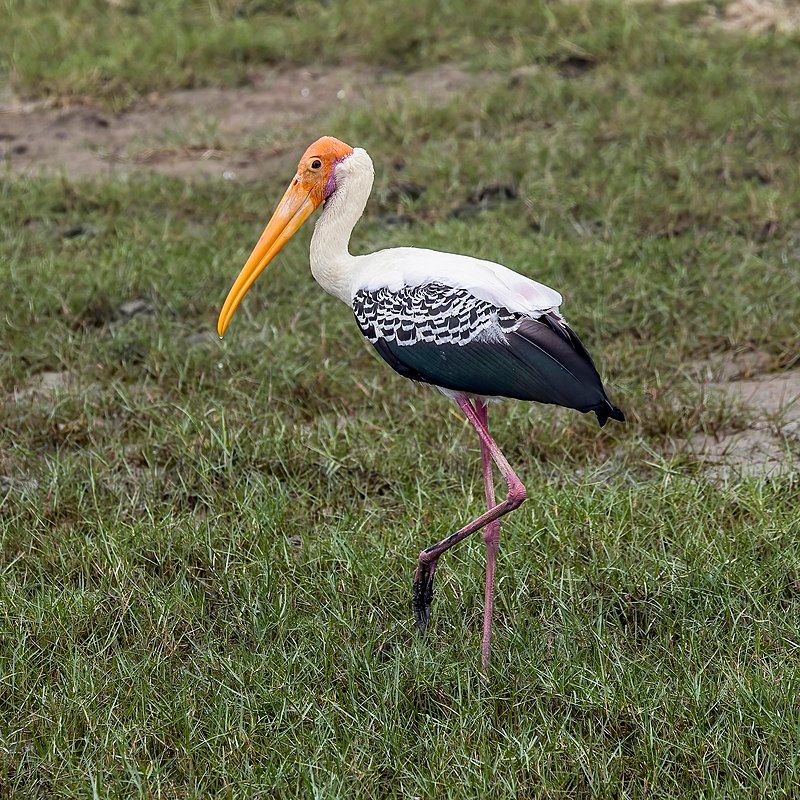
The painted stork is a large wader belonging to the stork family. It can be found in the wetlands of tropical Asia, stretching from the Indian Subcontinent south of the Himalayas to Southeast Asia.
This species gets its name from the distinctive pink terrestrial feathers of the adults. These feathers are located on the stork’s wings and contrast with the white feathers of the rest of the body.
The painted stork is generally found near rivers, lakes, wetlands, and other aquatic habitats. It is usually seen in large groups as a highly social species.
The painted stork is an omnivore, and its diet consists of various animal and plant matter. It is known to feed on small fish, frogs, insects, other aquatic creatures, and fruits, seeds, and other plant matter.
The painted stork is considered the least Concerning by the International Union for Conservation of Nature, as its population is stable and widespread.
| Kingdom | Animalia |
| Phylum | Chordata |
| Class | Aves |
| Order | Ciconiiformes |
| Family | Ciconiidae |
| Genus | Mycteria |
| Species | M. leucocephala |
23. Stork
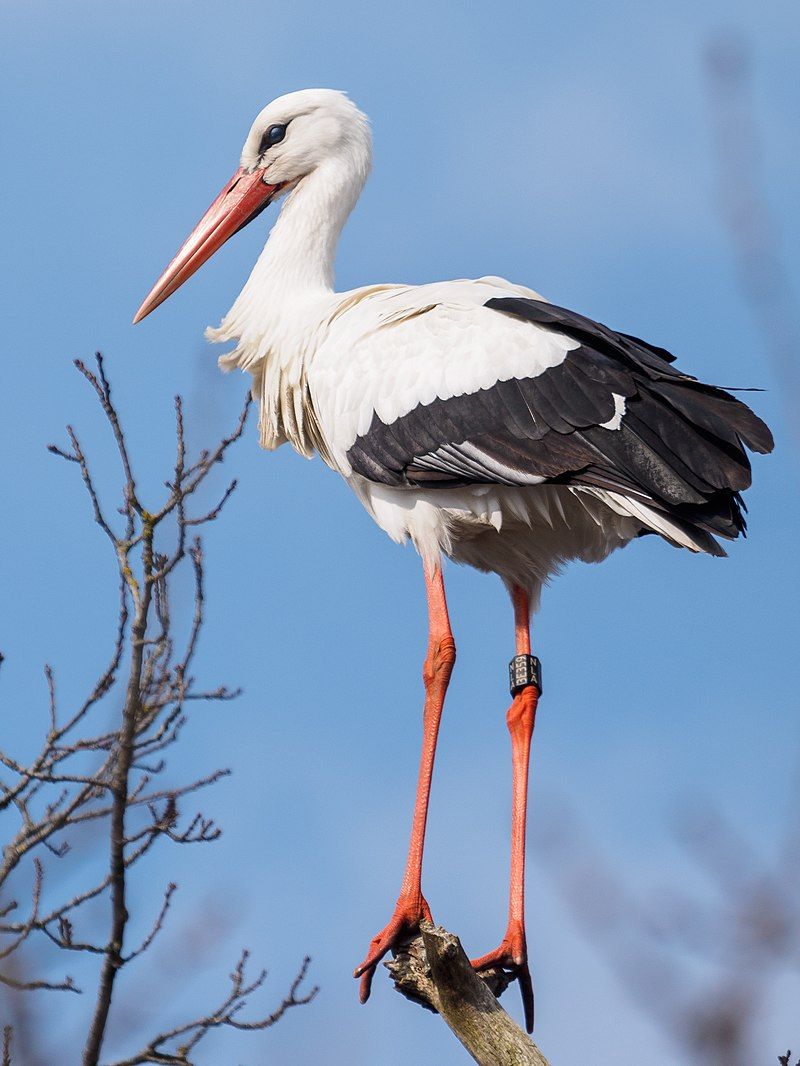
Storks are a bird that belongs to the family Ciconiidae and the order Ciconiiformes. These birds are known for their large size, long legs, and long necks. They also have a long, stout bill.
Ciconiiformes was a much larger order in the past, including families such as herons and ibises. However, these families have since been moved to other orders. Storks are a unique bird species, easily recognizable due to their distinct features.
They are often seen wading in shallow water, hunting for food. Their long necks and bills allow them to search for food in areas that may not be accessible to other birds. Storks are popular birds, often seen in many parts of the world.
| Kingdom | Animalia |
| Phylum | Chordata |
| Class | Aves |
| Clade | Aequornithes |
| Order | Ciconiiformes |
| Family | Ciconiidae |
24. Indian Spot-Billed Duck
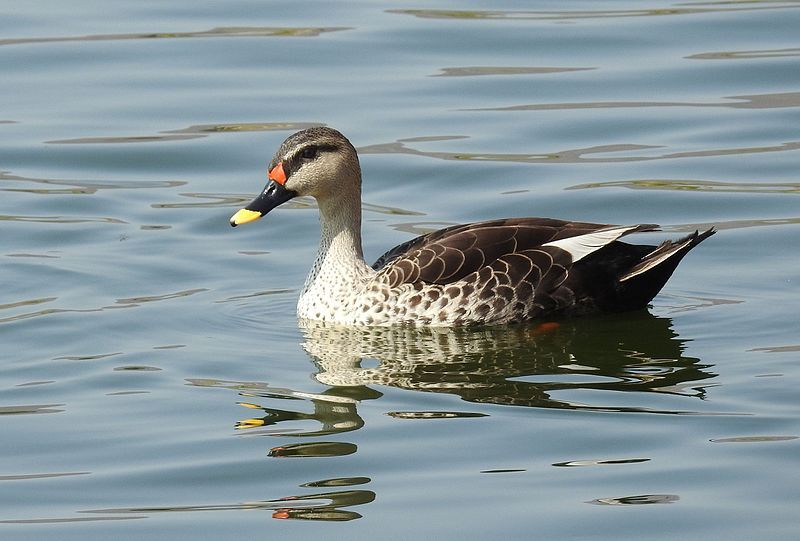
The Indian spot-billed duck is a large dabbling species native to the Indian subcontinent. This duck species is non-migratory, meaning they remain in the same area for breeding. They typically inhabit freshwater wetlands, such as ponds, lakes, and rivers.
The name “spot-billed” comes from the distinctive red spot at the base of the bill found on the mainland Indian population. This duck species is also known for its unique wing shape, distinguishing it from other duck species.
The Indian spot-billed duck is an essential part of the Indian ecosystem and is found in various habitats. These ducks are often seen in agricultural areas, where they feed on insects and other small creatures.
They are also famous in urban areas, where they can be seen swimming or wading in ponds and lakes. The Indian spot-billed duck is a beautiful and resilient species and an essential part of the Indian biodiversity.
| Kingdom | Animalia |
| Phylum | Chordata |
| Class | Aves |
| Order | Anseriformes |
| Family | Anatidae |
| Genus | Anas |
| Species | A. poecilorhyncha |
Conclusion
Birds in Chachoengsao are an essential and vibrant part of the local ecosystem. They provide a great source of food, and they can be a great source of entertainment and joy.
Bird watching is a popular hobby in the area, and it is a great way to observe the diversity of the local avian population. Furthermore, birds in Chachoengsao are essential to the local environment, providing many benefits, such as seed dispersal and pest control.
Therefore, it is essential to protect the birds of Chachoengsao so they can continue to thrive and provide these critical services to the local ecosystem.